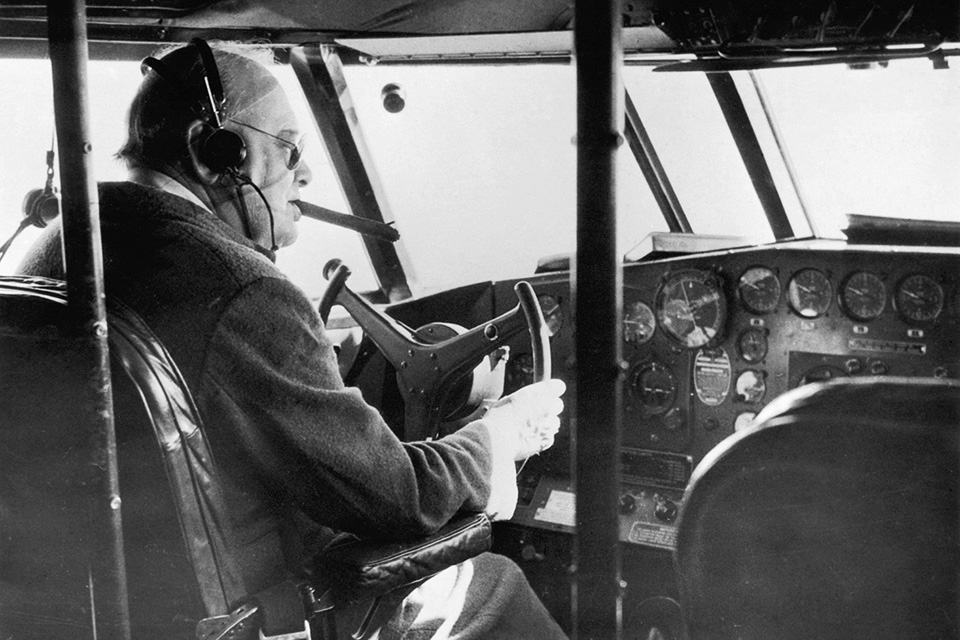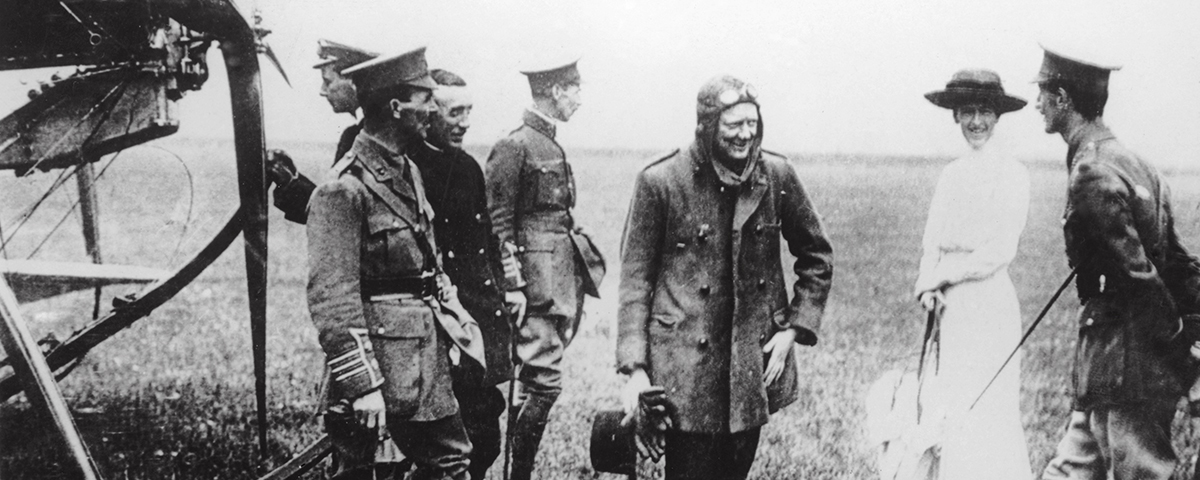The future prime minister’s passion for flying helped transform military aviation in Britain.
During a routine inspection tour of a Royal Naval Air Service facility in 1912, Winston Churchill took his first flight. It was only a short demonstration ride, but it would have far-ranging consequences for British military aviation.
When Churchill became First Lord of the Admiralty in 1911, he was just beginning his legendary political career, though at 37 he had already accomplished more than most men twice his age. His meteoric rise had brought him close to the pinnacle of political power, and he had been given responsibility for one of the most important tasks then facing the British government: overhauling the Royal Navy.
Churchill approached his role at the Admiralty with the same energy that had helped him accomplish so much before, but now it was focused by his vision for what a modernized Royal Navy could be. He realized that the future of naval warfare—and indeed warfare in general—would revolve around technology, and he was anxious to invest in its development. This emphasis on technology would include aircraft, despite the lack of interest in aviation evinced by the British government at the time. Churchill seems to have been captivated by the strategic potential of air power, and he saw how it could prove invaluable to the Royal Navy.
Shortly after he arrived at the Admiralty, he created the Royal Naval Air Service, and began to pour funding into it. Churchill’s newfound fascination with flight heightened his interest in the RNAS. His desire for time in the air led him to find excuses to visit the Naval Flying School at Eastchurch more often. He delighted in being taken up in the most advanced aircraft the RNAS possessed. With increased funding, the ranks of planes and pilots grew at an astonishing pace, and Churchill looked on with a mixture of paternal pride and boyish excitement.
By mid-1913, Churchill had succeeded in enacting many of his most rigorous reforms in the Royal Navy and had more time for flying. He spent several days at a time at Sheerness or Eastchurch, often taking multiple flights in a single day, while simultaneously dealing with running the world’s largest navy and negotiating Britain’s convoluted political landscape. Churchill’s time in the air served as a tremendous stress relief. He wrote to his wife Clementine: “It has been as good as one of those old days in the S. African war, & I have lived entirely in the moment, with no care for all these tiresome party politics.…”
Of course, flying was dangerous, and Clementine was not at all pleased with her husband’s new hobby. He tried to reassure her, writing: “I have been naughty today about flying. Down here with twenty machines in the air at once and thousands of flights made without mishap, it is not possible to look upon it as a very great risk. Do not be vexed with me.” Given the primitive aircraft of the day, however, accidents were a very real possibility—a reality brought home to Churchill during a trip to Sheerness, when a floatplane in which he was to take a demonstration flight crashed hours before his scheduled takeoff. The experimental nature of much of the RNAS fleet made safety an even greater concern. Undeterred, Churchill had by late 1913 begun flying lessons. Fortunately for him, his instructors were some of the most experienced aviators in the British military.
In the early 20th century, aviation instruction was as much in its infancy as any other aspect of flight. The lack of dual controls in most aircraft meant that the instructor had no way of regaining control of the plane in an emergency. Coupled with the unstable nature of airplanes at the time and the level of physical coordination necessary to operate them, it’s easy to see why 30 was considered the maximum age for a student pilot. As First Lord of the Admiralty, Churchill could disregard this restriction. His instructor pilots had no recourse but to take him up, but they did so with great trepidation given the possible damage to their careers if Churchill was injured or killed under their supervision.
Their fear was justified by Churchill’s performance in the cockpit. Though he was enthusiastic, he was easily distracted, falling into traps that ensnared many inexperienced fliers: fighting the controls, approaching landings at too high a speed and becoming fixated on the instruments. As a result, he continued to fly with an instructor long after most students would have soloed.
Churchill’s famous bravado would be tested on December 2, 1913, when one of his teachers, Captain Gilbert Wildman-Lushington, was killed while flying a Henry Farman biplane in which he had been training Churchill that same day. The accident, the first death of an RNAS officer while flying in the line of duty, brought home to Churchill the dangers of flight and the terrible cost in brave young men the development of aviation would require.
But as 1914 dawned, Churchill poured even more funding into the RNAS in an effort to transform his small air force into a unit capable of both supporting the fleet and protecting the British Isles. To that end the Admiralty purchased new aircraft and built training facilities. Churchill wrote his wife that he believed another year and another million pounds in funding would see the naval air service “alive and on the wing.” Among the many new aircraft was a Sopwith tractor biplane custom built to Churchill’s specifications, intended as his personal trainer. It included all the latest innovations, from dual controls to advanced instruments, and was designed around a more powerful engine meant to lift the First Lord’s considerable weight. The Sopwith reflected both the extent of RNAS development and Churchill’s growing aviation knowledge.
The first months of 1914 represented the zenith of Churchill’s personal aviation journey. He was flying frequently and beginning to see a return on his investment in the naval air service. With so many pilots, he was able to create a dedicated combat squadron, responsible for Britain’s aerial defense. The new unit was actually inadequate for such a monumental task—which Churchill fully realized—but it represented the first such squadron in any British military service.
Events on the horizon conspired to stall Churchill’s aviation ambitions and complicate RNAS growth. Diplomatic tensions already existed that could easily result in a war. Churchill was intimately involved with these problems, limiting his free time. Those difficulties, along with pressure from his wife, finally convinced him to give up flying in June 1914. In the letter announcing his decision, he wrote, “I will not fly any more until at any rate you have recovered from your kitten [the birth of their daughter]: & by then or perhaps later the risks may have been greatly reduced.” He also acknowledged for the first time the dangers of flying: “I must admit that the numerous fatalities of this year would justify you in complaining if I continued to share the risks….”
Churchill also chronicled his accomplishments, ostensibly to demonstrate how much he was sacrificing. These included using a machine gun in an airplane, taking off and landing. He claimed he had been in the air “nearly 140 times, with many pilots & all kinds of machines.” He also said that, as a result, he knew “the difficulties, the dangers & the questions of policy which will arise in the near future.”

Churchill’s grasp of aviation’s potential would prove to be the most lasting legacy of his flying experience. While learning to fly, he had also created one of the most advanced air forces, albeit a small one, in Britain, and possibly in Europe.
The outbreak of war in August 1914 of course changed everything for Britain. Churchill would have no time for flying for years. The war’s end and his assignment as the first Secretary of State for Air meant that he could again take flying lessons. During the first half of 1919, he made a concerted effort to master flying. But a crash in July of that year, which nearly killed his instructor and left Churchill badly shaken, finally put an end to his aerial aspirations.
Churchill wrote that after a routine take off “The machine made its first turn perfectly and the dial marked over sixty miles an hour, a thoroughly trustworthy flying speed. I now turned her to the left…and having put her on bank, I began to centre the guiding-stick slowly and gently in order to put her on an even keel….To my surprise the stick came home at least a foot without producing the slightest effect. The aeroplane remained inclined at about 45 degrees and began gradually to increase its list….The aeroplane was just turning from its side slip to nose dive when it struck the ground at perhaps fifty miles an hour with terrific force. The left wing crumpled, and its propeller and nose plunged into the earth.” Remarkably, Churchill walked away with only severe bruising; his instructor spent months in the hospital and had numerous reconstructive surgeries.
The real injury Churchill suffered was a loss of nerve. He seems to have finally understood just how dangerous his hobby really was. He never again took flying lessons. But the accident did not dampen his enthusiasm for air power. As Secretary of State for Air, he helped to preserve the Royal Air Force as an independent military branch. His choice of Hugh Trenchard, who would go on to be known as the “Father of the Royal Air Force,” as RAF chief of staff gave the new service the leadership required to forge a role for itself between the wars.
Churchill’s vision for British aviation was impressive. As he said to one of his flying instructors before World War I: “We are in the Stevenson age of flying. Now our machines are frail. One day they will be robust, and of value to our country.”
Originally published in the January 2012 issue of Aviation History. To subscribe, click here.





